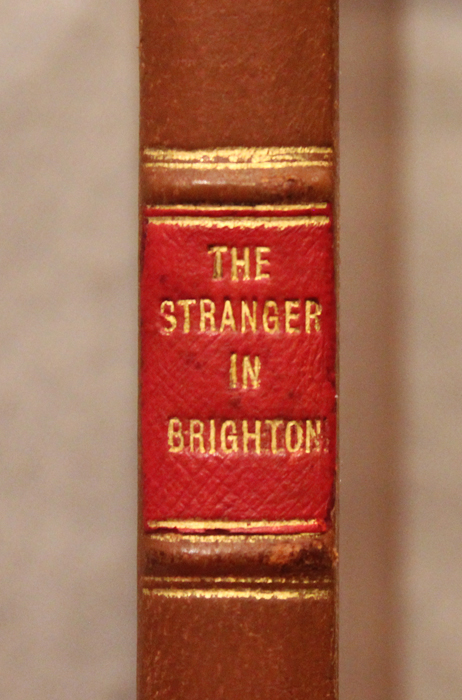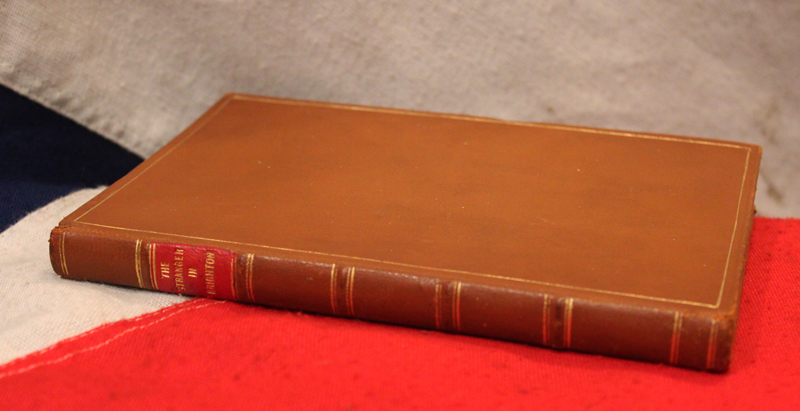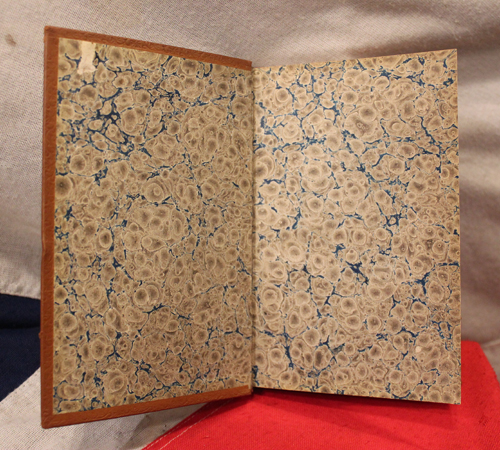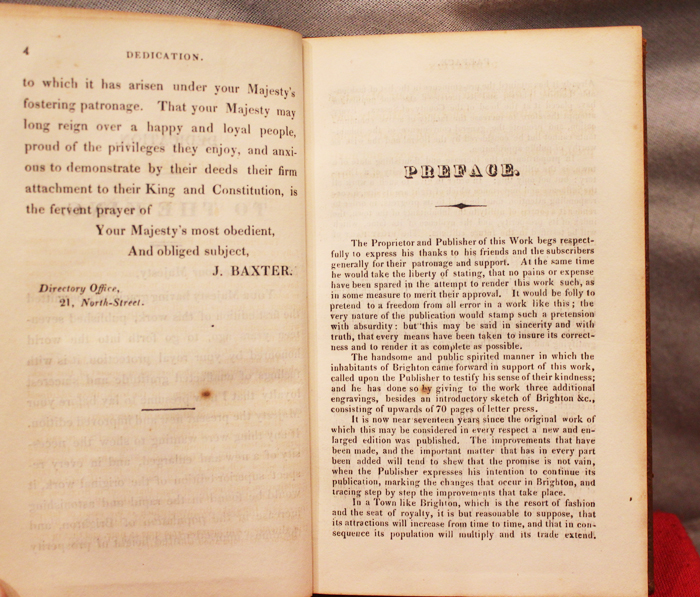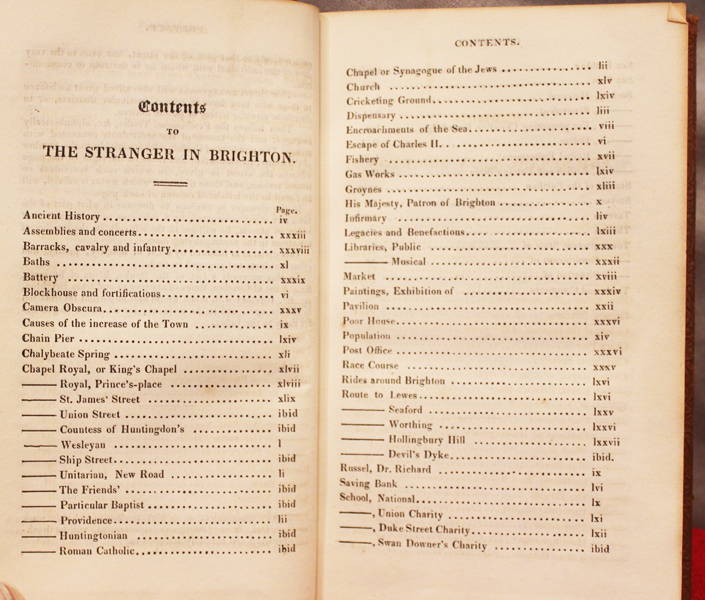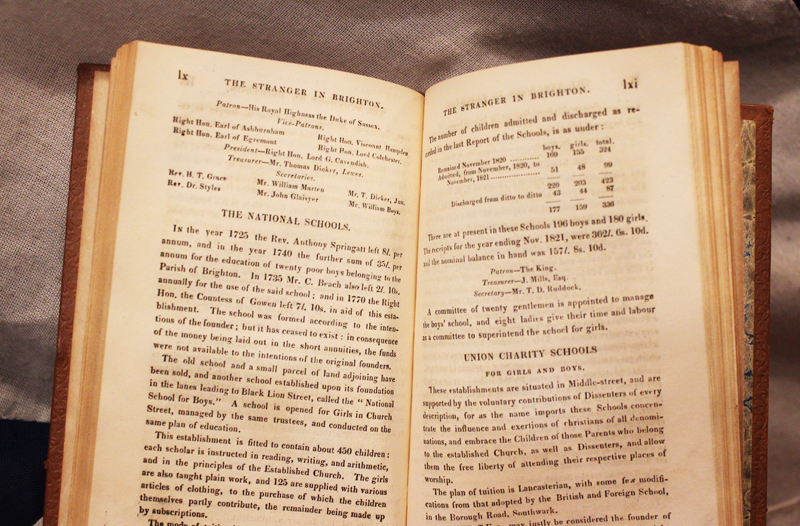A Most Rare, Circa 1822, Brown Calf & Morocco Leather Bound Volume of 'The Stranger in Brighton' & Baxter's Directory. Compiled and Published by by J.Baxter of North Street Brighton
These fabulous English Georgian period pocket directories are a wonderful snapshot of the inhabitants of the town, and it brings to life the characters and history of this extraordinary resort, made famous just a few years earlier by His Royal Highness the Prince of Wales.
Baxter’s Stranger in Brighton and directory : is a most rare and highly collectable volume, comprising a brief, yet comprehensive historical and topographical account of the town, and immediate neighbourhood ...Published circa 1822 by Baxter & Co. North St, Brighton Only a few hundred yards from our shop in the Lanes. Finely bound in light brown calf with calf spine and red Morocco leather and gilt title. The directory contains I. An alphabetical arrangement of inhabitant householders. II. An alphabetical arrangement of the professions. III. A list of coaches, waggons, carts, etc. Plus interesting tales of Brighton and its history and sights and places of interest. A wonderful and informative volume. According to J.H.Farrant Directories are an important source of information for studying the nineteenth century and the first half of the twentieth. For the family historian they help to identify the residence of individual people within narrow time limits; for the social historian they can indicate the internal structures of communities; for the economic historian the relative and changing importance of occupations and industries may be revealed, whilst the historical geographer can plot the spatial distribution of those activities. In few instances are directories undoubtedly better in quality of information than other sources: census enumerator’s tallies are more comprehensive and probably more accurate for identifying individuals; rate books can be much preferable for discovering the distribution of occupations and businesses; and so on. But directories have the indisputable advantage of being printed and published books.
Brighton is a seaside resort on the south coast of England which is now part of the city of Brighton and Hove, in the county of East Sussex, in England.
We are likely Brighton’s oldest gallery owners & family traders. And or over 100 years we have been based in the world famous area Of 'The Lanes' of Brighton, which is located in he very centre of Old Brighthelmstone Later re-named Brighton
Brighthelmstone, was recorded in the Domesday Book, the Norman detailed record of almost 1000 years past, of every city, town village and hamlet in England.
A town considered so important by our South Easterly neighbours, the French, that they sailed over the channel and burnt us to the ground.… at least twice.
Archaeological evidence of settlement in the area dates back to the Bronze Age, Roman and Anglo-Saxon periods. The ancient settlement of "Brighthelmstone" was documented in the Domesday Book (1086). The town's importance grew in the Middle Ages as the Old Town developed, but it languished in the early modern period, affected by foreign attacks, storms, a suffering economy and a declining population. Brighton began to attract more visitors following improved road transport to London and becoming a boarding point for boats travelling to France. The town also developed in popularity as a health resort for sea bathing as a purported cure for illnesses.
In the Georgian era, Brighton developed as a fashionable seaside resort, encouraged by the patronage of the Prince Regent, later King George IV, who spent much time in the town and constructed the Royal Pavilion in the Regency era.
4.75 inches x 7.25 inches. It mentions in the title page a map and three engravings, but in this deluxe calf leather binding {they were initially sold in simple grey board} there were no engravings or any indication they have been removed.
Code: 21263
450.00 GBP


